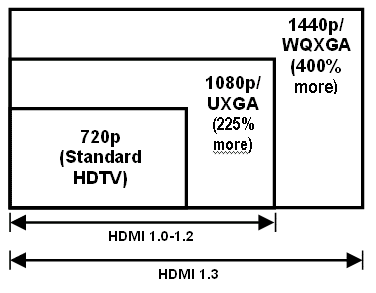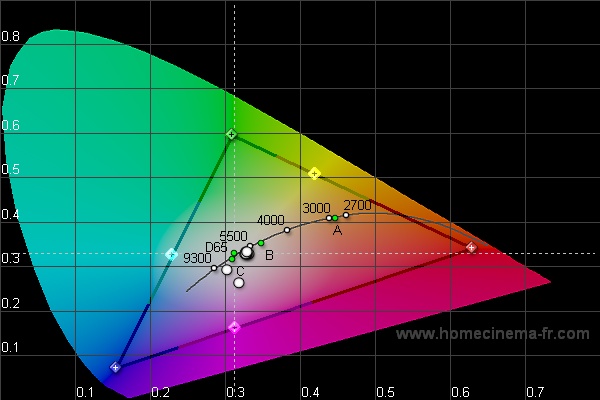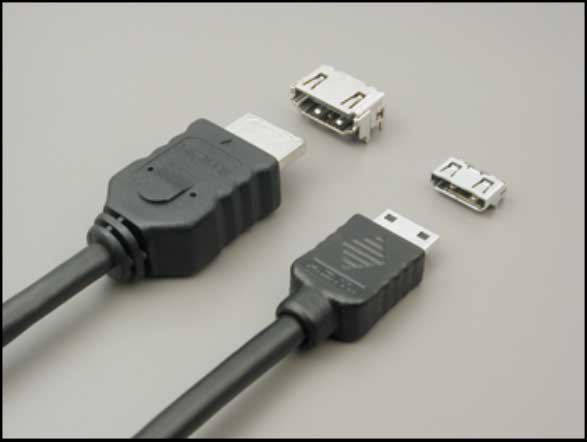Kleegamefan
K. LEE GAIDEN
Since 1080p is such a sore subject around these here parts, lets just bypass that and go right to 1440p!!!:lol
Here is an HDMI 1.3 Q and A over at audioholics:
http://www.audioholics.com/techtips/specsformats/HDMI13specificationQA.php
Here is an HDMI 1.3 Q and A over at audioholics:
http://www.audioholics.com/techtips/specsformats/HDMI13specificationQA.php
HDMI 1.3 has been the talk of the forums lately. Everyone wants to know what's going on with the new spec and what it means to the current and future crop of AV devices. We were fortunate enough to be able to do a brief Question and Answer exchange with Leslie Chard, President of HDMI Licensing, LLC to get a better idea of the recent changes to the HDMI spec. In particular we were interested in both the audio and video differences found in HDMI 1.3. Here is the result of our Q&A session.
Q:Audioholics: What specifically does HDMI 1.3 add to the 1.2a spec in terms of audio Video format support?
AHDMI 1.3 can support new formats and capabilities in both audio and video areas. HDMI 1.3 increases its single-link bandwidth from 165MHz (4.95 gigabits per second) to 340 MHz (10.2 Gbps).
With this increased bandwidth capability, HDMI 1.3 supports the demands of future high definition display devices, such as higher resolutions, high frame rates and Deep Color. Lets look at each of these specifically to see what it means to end users.
* Higher resolution HDMI 1.3 can provide over 450% the resolution of 720p HDTV, and over 225% of 1080p HDTV for greater detail and larger display sizes.

* Higher refresh rates. We are increasingly seeing a demand for display panels with a 90Hz refresh rate. We expect this trend to continue, as faster refresh rates create smoother motion and less blurring in motion sequences. This will have an especially significant impact on the gaming market, where we will see not only improved motion sequences, but also faster response times. HDMI 1.3 does not specify an upper limit to frame rates and it is expected that rates as high as 120Hz will be found.
* Deep Color HDMI 1.3 supports 30-bit, 36-bit and 48-bit (RGB or YCbCr 4:4:4) color depths, up from the 24-bit depths in previous versions of the HDMI specification.
o This will enable HDTVs and other displays to go from millions of colors to billions of colors.
o Eliminates on-screen color banding, for smooth tonal transitions and subtle gradations between colors (See picture below)
o Enables increased contrast ratio
o Deep Color displays can represent many times more shades of gray between black and white. At 30-bit pixel depth, a four times improvement would be the minimum, and the typical improvement would be eight times or more.
The chart below illustrates the relationship between bit depth and the number of possible colors:

HDMI 1.3 also eliminates color banding when Deep Color is utilized on the HDMI display (sink):


Q: Audioholics: Can you tell us about the new color space standard that HDMI 1.3 supports?
A: The new xvYCC color standard is a real innovation. Current color standards represent only a small portion of colors that are viewable by the human eye. Take a look at the diagram (below). This is a standard type of diagram used to display color spaces (the colors that can be depicted by a given device). The shaded area represents the colors in nature that the human eye can see. The triangle is a representation of the RGB color space. These are the colors that this color space can define. As you can see, this means that such devices cannot accurately represent many colors that exist in nature leading to the sometimes cartoony look that you see on some displays. What is worse is that current display technologies, such as backlit LCD displays, can display colors far beyond those described by previously existing color space standards. R G B
CURRENT RGB COLORSPACE

By implementing the xvYCC color space standard, HDMI 1.3 removes virtually all limits on color selection and supports 1.8 times as many colors as existing HDTV signals. This is because the xvYCC color space standard defines colors by means of an algorithm that can specify any color in nature. This lets HDTVs display colors more accurately and with more natural and vivid colors. The first TV to use this standard was the Sony Bravia, which premiered at the 2006 CES in Las Vegas
Q: Audioholics: What about new audio formats?
A: In terms of audio, HDMI 1.3 adds additional support for new, lossless compressed digital audio formats Dolby® TrueHD and DTS-HD Master Audio which provide up to 8 channels of lossless surround sound. This will give users the highest quality audio experience the same as in the movie theater.
Q: Audioholics: Are additional form factors available for HDMI 1.3?
A: Yes. With small portable devices such as HD camcorders and still cameras demanding seamless connectivity to HDTVs, HDMI 1.3 offers a new, smaller form factor connector option. The new Type C HDMI mini connector (pictured below, next to the current HDMI connector) was designed for portable devices.
*OPTIONAL* (as in used for smaller stuff like camcorders)HDMI 1.3 "Type C" miniconnector

Q:Audioholics: Based on your conversations and interactions with manufacturers, when do you think we might start seeing HDMI 1.3-enabled display and AV processing devices (e.g. this year, next year)?
A:According to announcements by manufacturers, new high-definition DVD formats (HD-DVD and Blu-ray) and game machines (including the Sony PLAYSTATION® 3) will make use of capabilities added in HDMI 1.3. Digital televisions will be able to present images that are closer to real life than previously has been possible. These will include LCD TVs, plasma displays and rear projection microdisplays. The PS3 which is scheduled to ship in November 2006, will be the first source product to provide such high quality imagery to these displays. It is expected that hi-def DVD players will follow early in 2007 with HDMI 1.3 support. A/V Receivers that can decode DTS-HD Master Audio and Dolby TrueHD will start to show up early in 2007 as well. Please check with the manufacturers for details.
Q:Audioholics: Will lossless Dolby TrueHD and DTS-HD be supported in up to 7.1 formats?
A: According to the Dolby web site, Dolby TrueHD can support more than 8 audio channels. According to the DTS web site, DTS-HD offers 7.1 channel capability. Current specifications for HD-DVD and Blu-Ray limit the audio to eight channels.
Q: Audioholics: Did any cabling or tolerance parameters change for the specification?
A: HDMI 1.3 increased the single-link bandwidth from 165MHz (or 4.95 gigabits/second) to 340MHz (or 10.2 gigabits/second). This was accomplished through the addition of receiver cable equalization, which is technology present in the HDMI receiver chip (in the display) that compensates for the signal deterioration caused by cables. In addition, source pre-emphasis (which emphasizes bit transitions) and source termination (which minimizes noise generation by the connectors) are now permitted for higher speed devices.
Q: Audioholics: What part did the new gaming consoles, Blu-ray, and HD DVD technologies play in structuring the new specification?
A: The HDMI Founders include many Consumer Electronics leaders who design, manufacture and sell the gamut of consumer electronic components and devices. The HDMI standard continues to evolve to allow manufacturers to bring the most advanced technologies to market. The HDMI standard does not react to any one specific category of product. Rather, the products that are now being released represent the latest innovations from these companies and the HDMI standard reflects the need to support such industry innovations.
Q: Audioholics: Are there mandatory and non-mandatory audio and/or video formats present in the latest format?
A: HDMI 1.3 was created to support new higher-bandwidth audio and video formats; however, it is the prerogative of each manufacturer to take advantage of these capabilities. None of these new audio or video formats are mandatory. We do not want to mandate functionality, and increase product prices, where it is not needed.
Q: Audioholics: Does HDMI 1.3 specifically address any PC market issues?
A: Yes. The increased bandwidth (with support of 1440p/WQXGA monitors) now supports all current PC monitors that ship today. Further, 1.3s Deep Color capabilities support a clear trend in the development of PC display capabilities.
- Clint DeBoer
Thanks to Leslie Chard, President of HDMI Licensing, LLC for his time in answering these questions.

